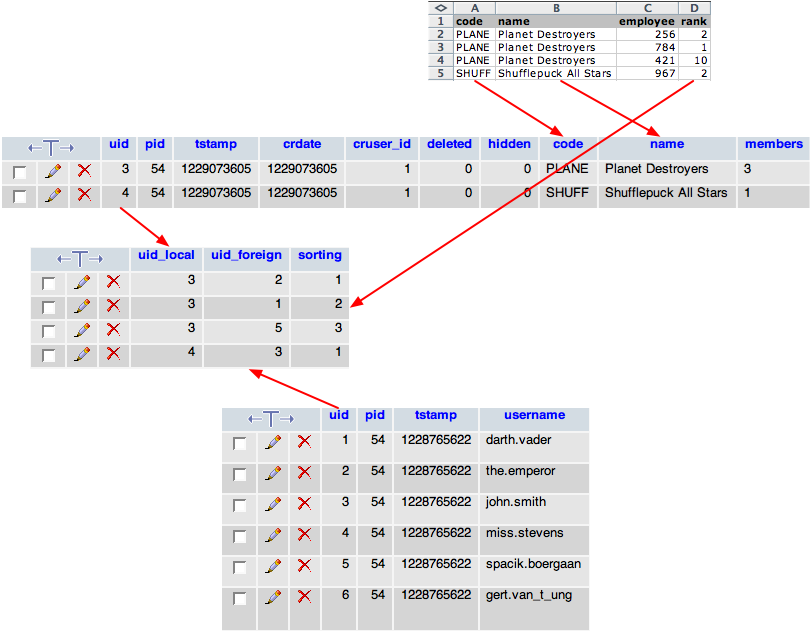DEPRECATION WARNING
This documentation is not using the current rendering mechanism and is probably outdated. The extension maintainer should switch to the new system. Details on how to use the rendering mechanism can be found here.
The teams¶
The last data to be imported is the teams. This is mostly like departments, except that teams have a many-to-many relationship to employees. Indeed a team will be comprised of several employees and any employee may be part of several teams.
When such data comes along, the external_import extension expects it to be denormalised. This means that if team A contains 3 employees, there will be 3 entries for team A, each with a relationship to a different employee. Let’s look at the example data:

CSV data in the temas.txt file
We clearly see that the “Planet Destroyers” team appears three times, because it is comprised of employees 256, 421 and 784. External import takes this into account by making sure that it keeps a single copy of each team, based on the external primary key (the “code” field in this case).
Note
It is also possible to create MM-relationships with data represented as a comma-separated list of keys, commonly used in TYPO3.
In the example data above, you can see that there’s a “rank” field. This will be used to set the “sorting” column in the MM-relations table.
The SQL for the teams table is not repeated here as it is quite standard. The MM-relations table is also an absolutely standard TYPO3 table for MM-relations:
CREATE TABLE tx_externalimporttut_teams (
uid int(11) NOT NULL auto_increment,
pid int(11) DEFAULT '0' NOT NULL,
tstamp int(11) DEFAULT '0' NOT NULL,
crdate int(11) DEFAULT '0' NOT NULL,
cruser_id int(11) DEFAULT '0' NOT NULL,
deleted tinyint(4) DEFAULT '0' NOT NULL,
hidden tinyint(4) DEFAULT '0' NOT NULL,
code varchar(5) DEFAULT '' NOT NULL,
name varchar(255) DEFAULT '' NOT NULL,
members text,
PRIMARY KEY (uid),
KEY parent (pid)
);
The “external” definition of the team’s table “ctrl” section is also not repeated here as it does not contain anything not already covered in this tutorial. The really interesting part is the “external” information for creating the relationship between teams and fe_users. The definition is to be found in the “members” column of the teams table:
$GLOBALS['TCA']['tx_externalimporttut_teams'] = [
...
'columns' => [
...
'members' => [
'exclude' => 0,
'label' => 'LLL:EXT:externalimport_tut/Resources/Private/Language/locallang_db.xlf:tx_externalimporttut_teams.members',
'config' => [
'type' => 'group',
'size' => 5,
'internal_type' => 'db',
'allowed' => 'fe_users',
'MM' => 'tx_externalimporttut_teams_feusers_mm',
'maxitems' => 100
],
'external' => [
0 => [
'field' => 'employee',
'MM' => [
'mapping' => [
'table' => 'fe_users',
'referenceField' => 'tx_externalimporttut_code',
],
'sorting' => 'rank'
]
]
]
],
],
...
];
Looking at the TCA for this column, you can see that it contains the traditional information for a MM column. The external part describes the column as pointing to the “employee” field, which contains the employee number as we saw above. It then contains a “MM” section which describes how the relationships can be created on the TYPO3 side. The main part is the “mapping” information which is similar in syntax to what we saw for simply mapped fields (a.k.a one-to-many relationships). It references a table and the column in that table which contains the external primary key.
Additionally it is possible to choose a field from the external data that will be used to define the sorting of the relationships. In this case it is the “rank” field. If this is not defined, the sorting will be simply based on the first in, first out basis (i.e. the first record will have a sorting of 1, the second a sorting of 2, etc.).
Note that it is currently not possible to define a sorting field for the “sorting_foreign” column, should you have such a configuration. Sorting is always relative to the “uid_local” column.
After running the teams import, you should get something like this:

The team data imported into the database with relations to FE users (members)
We can see that the teams were properly related to the fe_users. The sorting has also been kept correctly although with a renumbering (done automatically by DataHandler).